
Features
Training
Back to Basics: August 2014
In June, we looked at master-stream operations. Now we are going to look at different uses of ground-deluge systems or ground master streams.
August 5, 2014
By Mark van der Feyst
In June, we looked at master-stream operations. Now we are going to look at different uses of ground-deluge systems or ground master streams.
Ground master streams provide a way for engine companies to deliver water at high flow rates with effective results. These devices are an asset for departments in defensive operations; ground master streams also offer safety, as the reach allows firefighters to be a safe distance from fire.
As with an elevated master stream, options for ground deluges are a straight tip or an automatic combination nozzle; each provide a sustainable reach for safe fire-ground operations.
The tip choice depends on water-supply issues, pump capacity and length and size of the supply hose being used. Smooth-bore tips require half the pressure of an automatic combination nozzle; this is a great advantage when pump capacity is an issue or in long hose-lay situations.
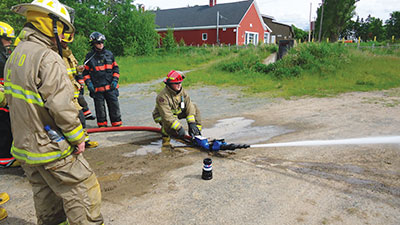 |
|
| Photo 1: Some master-stream systems are designed to be set up and then left unmanned while they flow water. Photos by Mark van der Feyst |
|
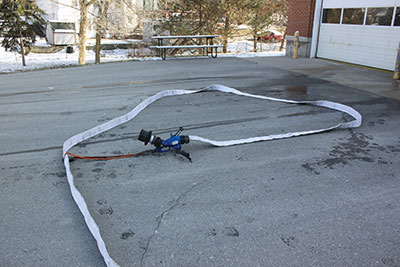 |
|
| Photo 2: The supply hose is looped around the front of the device with a minimum three-metre radius. The device is secured to the hose by a piece of webbing or a hose strap. When the hose is charged with water, it becomes the anchor for the device. | |
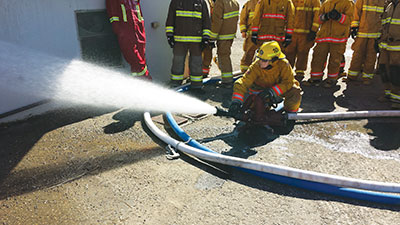 |
|
| Photo 3: A two-hose system. | |
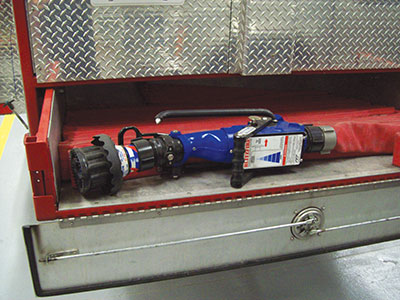 |
|
| Photo 4: Some portable ground monitors are designed to have just one 65-mm supply line. One firefighter can grab the pre-connected monitor and set it up with the device not having to be anchored to the hose. | |
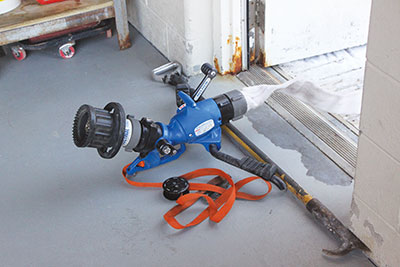 |
|
| Photo 5: A small or regular-sized ground monitor can be set up for interior water flow. It provides a large quantity of water and a long reach to knock down fires in large buildings or long hallways. |
Most ground-deluge systems are designed so that one firefighter can handle set up. These high-volume systems need to be manned. If a master stream needs to be shut down right away, it is crucial that an operator be present. Some systems are designed to be set up and then left unmanned while they flow water (see photo 1); when the device detects any kind of movement, it shuts down immediately. Systems can be tested for shut-down by hitting the top part of the device with your hand; if the shut-down is working, the system will stop flowing water right away.
There are two choices for supply hose for these systems: 100-millimetre (four-inch) large-diameter hose, or 65-mm (two-and-a-half-inch) supply hose. If large-diameter supply hose is being used, a single inlet system will be employed rather than two 65-mm supply hoses required for the smaller size.
Regardless of the size of hose, there is a standard way to set up the ground deluge or master stream so that it will not move away while flowing water. In photo 2, you can see that the supply hose is looped around the front of the device with a minimum three-metre (10 foot) radius. The device is secured to the hose by a piece of webbing or a hose strap. The idea with this set up is that when the hose is charged with water, it becomes the anchor for the device. In photo 3 you can see how a two-hose system looks.
Some of the newer portable ground monitors are designed to have just one 65-mm supply line, for ease of use and set up. One firefighter can easily grab the pre-connected monitor (see photo 4), advance it, and set it up with the device not having to be anchored to the hose. The difference is that the supply hose needs to be in a straight line behind the monitor for about two to three metres (six to 10 feet); this ensures that the monitor works effectively.
Another application for the ground monitor is interior offensive operations. In photo 5 you can see how we can take a small or regular-sized ground monitor and set it up for interior water flow. Why use it this way? Because it provides a vast amount of water and a long reach in order to achieve knockdown in a large building or a long hallway.
Notice in the photo the use of the anchor point across the doorway. A pry bar, a roof hook or a pike pole is needed so the ground monitor can rest against it and not be pushed back while flowing water. This is useful for highrise fire fighting or in large, open warehouses and apartment buildings.
Master streams and ground deluges can be used with any type of apparatus.
Do not overlook the ground monitor as a useful tool when large water delivery is needed. Pull the ground deluge out from the truck storage compartment and practice setting it up and flowing water.
Mark van der Feyst is a 15-year veteran of the fire service. He works for the Woodstock Fire Department in Woodstock, Ontario. Mark instructs in Canada, the United States and India and is a local-level suppression instructor for the Pennsylvania State Fire Academy and an instructor for the Justice Institute of B.C. Email Mark at Mark@FireStarTraining.com
Print this page